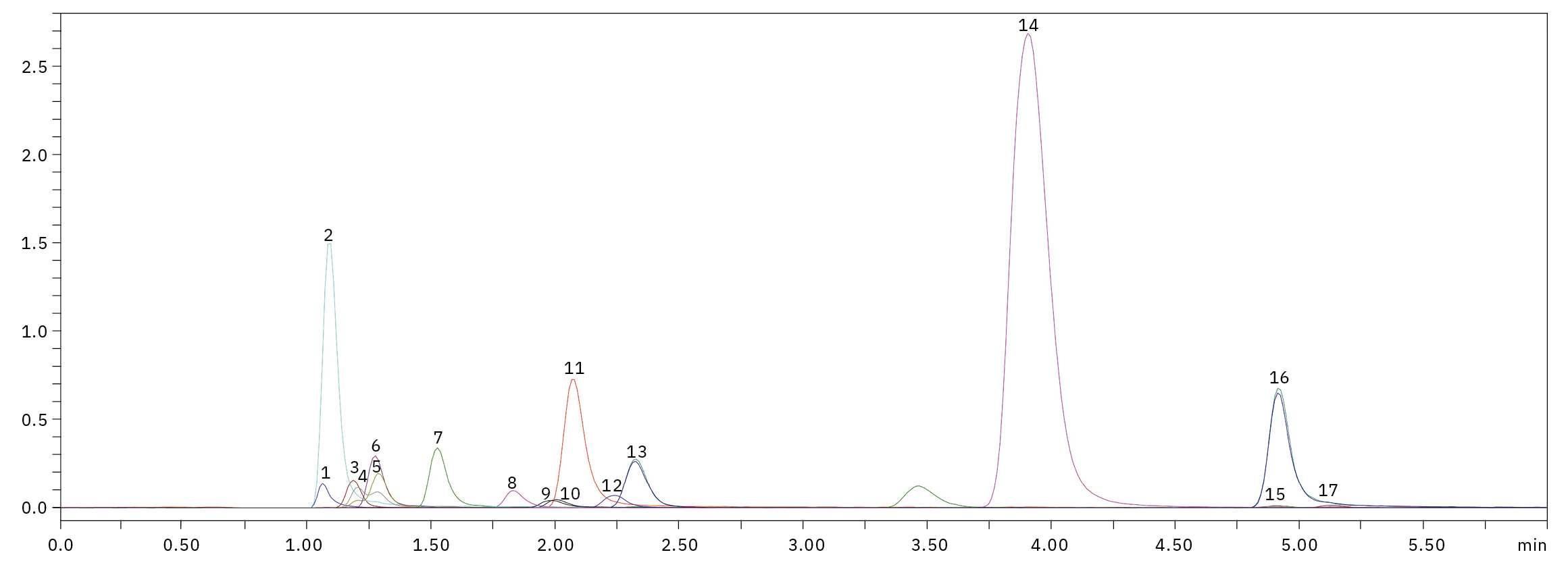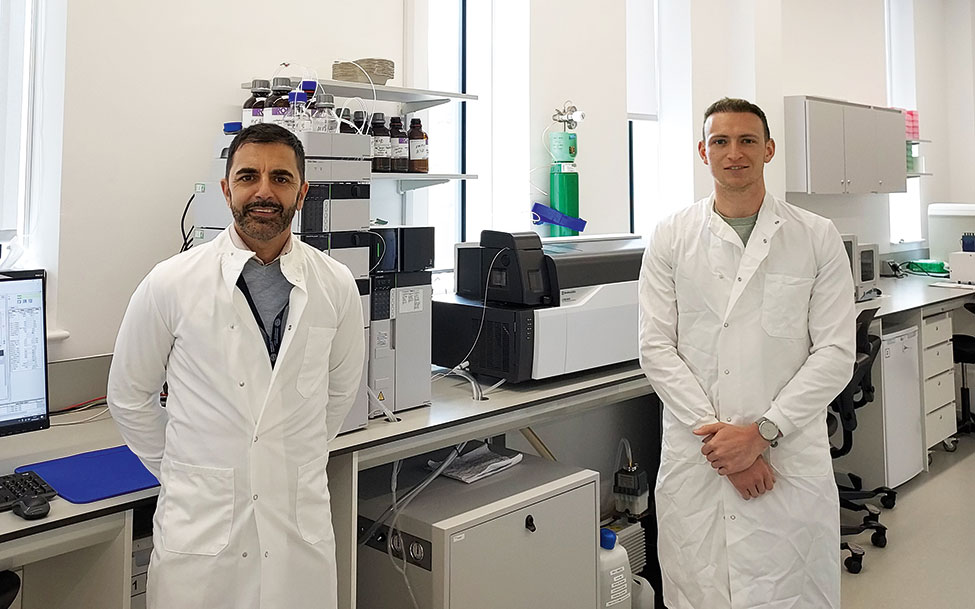Critical mass: Studying treatments for age-related muscle loss
How researchers are using LC-MS/MS to investigate amino acids in blood plasma
Dr. Theocharis Ispoglou, Luke Aldrich, Leeds Beckett University
Loss of muscle mass and strength, known as sarcopenia, is a significant cause of hospitalization and loss of independence in older people. Researchers at Leeds Beckett University’s Carnegie School of Sport are on a mission to understand the effect of amino acid supplements and steroid hormones on muscle mass. We talk to them about how the adoption of Shimadzu’s LC-MS equipment has revolutionized their ability to examine levels of these small molecules in blood plasma and to monitor how they change during efforts to prevent and better manage sarcopenia.
The challenge of muscle loss (sarcopenia)
Sarcopenia is the medical term for the progressive (and often rapid) loss of muscle mass and strength. It is typically associated with ageing, physical inactivity and inadequate nutrition as the key causative factors and is estimated to affect about 10 % of those aged 60 or over, a proportion increasing further with advancing age. The reductions in muscle mass and strength make it difficult to perform everyday tasks and lead to a loss of independence, reduced quality of life, an increased risk of falls and associated hospitalization or long-term care.
Although the risk factors for sarcopenia are complex and multifaceted, a key factor underlying the disease is a reduction in the body’s ability to synthesize protein (often due to lack of muscle use), which leads to a reduced mass of skeletal muscles. One way of boosting muscle mass is to increase consumption of high-quality proteins, namely the branched chain amino acids or BCAAs, and taking protein and amino acid supplements is also recommended by many authorities. However, optimizing interventions using amino acid supplements is difficult because of a lack of understanding about what happens to them in the body and the limited number of well-controlled trials assessing their efficacy.
Using LC-MS to monitor amino acids in the body
One of the many research groups tackling this challenge is a team led by Dr. Theocharis Ispoglou at the Carnegie School of Sport. Part of Leeds Beckett University, the school is one of the largest UK providers of higher education sports courses, but also undertakes research programs, including several focused on improving human health.
The work of Dr. Ispoglou is firmly aligned with that objective, and over his 17 years at the Carnegie School of Sport, he has increasingly focused on the role of nutritional and exercise interventions in optimizing muscle health across the lifespan. “In my current research, I’m focusing on how nutritional supplements, alongside a balanced diet and exercise, can help us age more healthily, considering the clinical setting and not just the sports side,” he explains.
One of the team’s current projects is directly related to sarcopenia and is being carried out by Ph.D. research student Luke Aldrich, who is jointly supervised by Dr. Ispoglou and by Dr. Antonis Stavropoulos (also at the Carnegie School of Sport). For the last 18 months, he has been using Shimadzu’s LCMS-8045 system to undertake investigations into how the composition of amino acid supplements affects the blood plasma concentrations of a range of essential amino acids. To enable solid conclusions to be drawn, Luke explains, the work has involved an intensive sampling regime: “Recently, we completed a study involving 10 adults over the age of 60, which consisted of three trials. Each of these involved collecting blood samples at eight time points over a period of four hours, with a total of 240 samples being collected in the study as a whole.”
Increased sample number enables more precise results
The number of samples in itself breaks new ground for the group, which in the past had to outsource their analyses: “There was no way we could have done something like that previously because of the cost,” says Dr. Ispoglou. “But now, with the sampling limitation removed, we can take as many time points as we need and so generate more detailed and informative concentration curves for amino acids in the blood plasma.”
Understanding causative links thanks to new capabilities provided by LC-MS
But it is not just the study design that is proving fruitful – the analytical methodology also marks a milestone, simply because LC-MS is not widely used in the fields of sports nutrition and exercise science. With analytical targets commonly being proteins or hormones, it is normal for researchers to use immunoassays for analysis, and they tend not to have in-house access to chromatographic techniques for smaller molecules or the experience to use them effectively.
But by having easy access to an LC-MS system, Dr. Ispoglou’s team has been able to make significant progress: “All the data we get from LC-MS helps us obtain a fuller and more accurate picture of what’s happening, meaning that we’re now in a much better position to look at potential causative and mechanistic links. These are things that we certainly couldn’t have done before!”

| Amino acid | Retention time (min) | |
| 1 | Tryptophan | 1.073 |
| 2 | Phenylalanin | 1.100 |
| 3 | Tyrosin | 1.195 |
| 4 | Leucin | 1.213 |
| 5 | Methionin | 1.280 |
| 6 | Isoleucin | 1.296 |
| 7 | Valin | 1.530 |
| 8 | Threonin | 1.830 |
| 9 | Alanin | 1.975 |
| 10 | Serin | 2.000 |
| 11 | Prolin | 2.064 |
| 12 | Asparagin | 2.226 |
| 13 | Glutamin | 2.312 |
| 14 | Arginin | 3.877 |
| 15 | Glutaminsäure | 4.857 |
| 16 | Lysin | 4.861 |
| 17 | Asparaginsäure | 5.060 |
Thorough training and on-the-spot support
This change in capability only came about because of a major investment by Leeds Beckett University in the Carnegie School of Sport. Opened in 2020, the new building brought together previously separate facilities under one roof – and importantly for Dr. Ispoglou, it was a unique opportunity to expand the laboratory facilities available to his group. “We had done some preliminary research about the sensitivity and specificity of LC-MS, and we knew it would be perfect for our research. I led the bid from start to finish, guided by Dr. John George from the School of Health, who has extensive expertise and knowledge in LC-MS. I was delighted that the Shimadzu team made a very competitive offer, and their system came out on top – for me, it was a dream that I’d been chasing for years!”
But because no-one in the group had prior experience of LC-MS, with their new equipment came a need for training. Luke Aldrich picks up the story: “We received the LC-MS in November 2021, and shortly after that we had our first training session from Shimadzu. We were starting from scratch, but our Shimadzu trainers were great, going through the theoretical side of the chromatography first, followed by an introduction to operating the system as well as training on data analysis, sample preparation and standard preparation – the whole lot!”
The Shimadzu team has also been really responsive, says Luke, providing rapid support by email or phone any time they need it: “They’re straight on to it and really helpful. In the last six months, we have often benefitted from same-day on-site support from Shimadzu technical specialists. Not many manufacturers offer that level of service.”
One challenge faced by the team at the outset was the lack of suitable methods for sample preparation. Luke says: “Although we had a good method for LC-MS analysis of amino acids, the sample prep stage wasn’t applicable to blood plasma. But with help from Shimadzu, we were able to make some modifications, including changing the diluent, adjusting the acidity, optimizing the filtration step and more. They really helped us to work through the different options to ensure we got the best possible recovery and data quality.”
Future steps already in the making
At the time of writing (June 2023), a 30-adult study has recently been completed, with preliminary results showing clear differences in amino acid levels between a control group versus those undertaking either an exercise regime or a program of nutritional supplements. The results are yet to be published, but Dr. Ispoglou says that the work seems to support the findings of an earlier case study carried out by the team with a 57-year-old with sarcopenia:[1] “In this early work, we showed that the sum total of 17 amino acids increased by 19.1 % after 24 weeks of an exercise and dietary intervention – in line with the literature in this area. So, we’re really looking forward to publishing the results of our new much larger study!”
Following this work, the next stage for the team is to extend their analyte coverage to the steroid hormones present in blood plasma. Such steroids are another factor in sarcopenia and one the team has been interested in for some time. Luke is currently completing method development for these analyses and says that the analysis allows detection of 11 hormones plus vitamin D within 6 minutes: “Considering that in the past we would have to develop a different immunoassay for each hormone, that’s incredible, really!”
Two further projects that the team are developing, and which will also use LC-MS, involve the School of Health at Leeds Beckett. The lead researcher will be Dr. John George, who says that the first study will use LC-MS to reveal the biochemical pathways involved in regulating the biogenesis of the cell envelope of Gram-negative bacteria, which could be important for understanding how these cells grow or achieve homeostasis as well as aiding potential drug discovery attempts. The second project, he says, will involve challenging bacteria with a number of antibiotics and monitoring their cellular response by LC-MS, potentially aiding the discovery of new drugs targeting antibiotic-resistant bacteria.
LC-MS is helping sarcopenia research get to the next level
Dr. Ispoglou concludes that the availability of the Shimadzu LC-MS equipment within the new laboratory facilities at the Carnegie School of Sport has been a game-changer for the team’s ambitions. “To continually advance your research, you need to invest in equipment and people, and our new instrumentation has absolutely enabled us to take our research to the next level,” he says. “LC-MS certainly has the potential to foster the development of novel insights in the field of sport, exercise science and nutrition.”
And through it all, it is clear that the Shimadzu team has been central to helping the team get started with LC-MS, says Dr. Ispoglou: “They’ve been incredible, and our experience has been highly positive. It’s clear to me that they genuinely care about what we’re doing, and they want us to do the best with the data we have.” Luke agrees: “We can’t fault Shimadzu at all – the equipment is reliable, and the service has been brilliant!”
[1] T. Ispoglou, P. Ferentinos, K. Prokopidis, C. Blake, L. Aldrich, A. Elia, M. Lees and K. Hind, A case study on the impact of exercise and essential amino acid supplementation on physical fitness and body composition, Authorea, 2023 (preprint), https://doi.org/10.22541/au.168242070.05644106/v1
